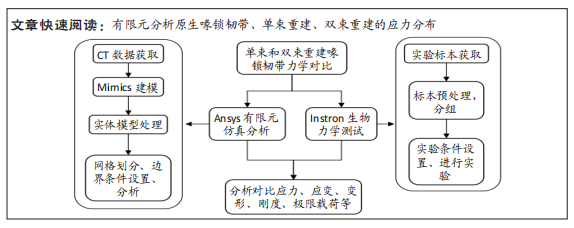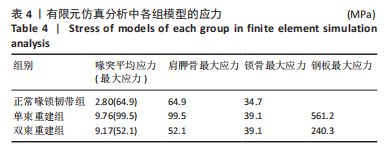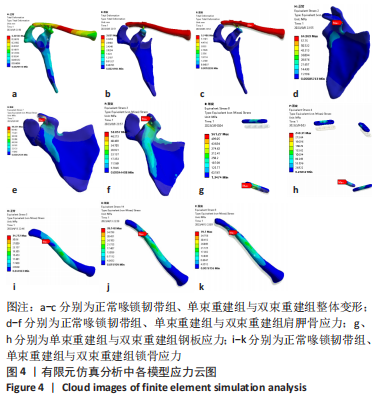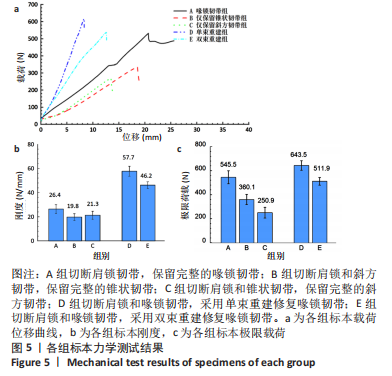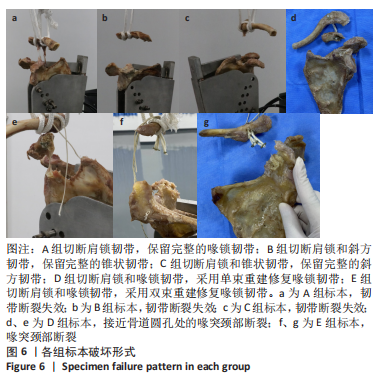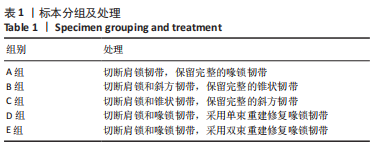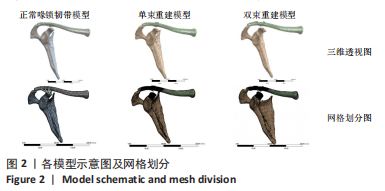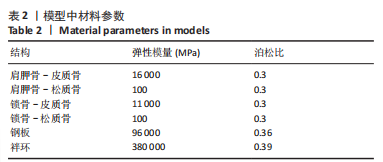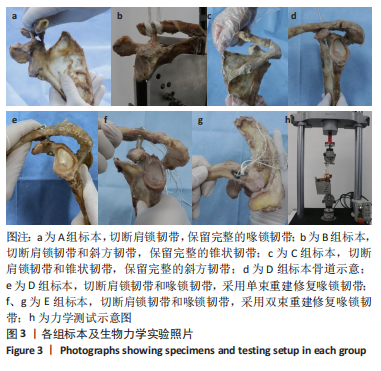[1] KIM AC, MATCUK G, PATEL D, et al. Acromioclavicular joint injuries and reconstructions: a review of expected imaging findings and potential complications. Emerg Radiol. 2012; 19(5):399-413.
[2] HU F, HAN S, LIU F, et al. A modified single-endobutton technique combined with nice knot for treatment of Rockwood type III or V acromioclavicular joint dislocation. BMC Musculoskel Dis. 2022;23(1):15.
[3] 彭明学,钱亮,孙策勇.双股钢丝袢喙锁间固定治疗TossyⅢ型肩锁关节脱位[J].四川医学,2011,32(7):1122-1123.
[4] SUNDARAM N, PATEL DV, PORTER DS. Stabilization of acute acromioclavicular dislocation by a modified Bosworth technique: a long-term follow-up study. Injury. 1992;23(3):189-193.
[5] LEE SJ, EOM TW, HYUN YS. Complications and Frequency of Surgical Treatment with AO-Type Hook Plate in Shoulder Trauma: A Retrospective Study. J Clin Med. 2022;11(4):1026.
[6] CHEN CH, DONG QR, ZHOU RK, et al. Effects of hook plate on shoulder function after treatment of acromioclavicular joint dislocation. Int J Clin Exp Med. 2014;7(9):2564-2570.
[7] ARIRACHAKARAN A, BOONARD M, PIYAPITTAYANUN P, et al. Post-operative outcomes and complications of suspensory loop fixation device versus hook plate in acute unstable acromioclavicular joint dislocation: a systematic review and meta-analysis. J Orthop Traumatol. 2017;18(4):293-304.
[8] HUANG D, HU Z, FENG W, et al. Dual plate has better biomechanical stability than hook plate or superior single plate for the fixation of unstable distal clavicle fractures: a finite element analysis. Arch Orthop Traum Surg. 2023. doi: 10.1007/s00402-023-04801-5.
[9] PARK I, LEE S, SHIN SJ. Arthroscopic-Assisted Double-Bundle Coracoclavicular Ligament Reconstruction Using Cortical Fixation Buttons With Suture Tape Provides Superior Vertical Stability Than the Single-Bundle Reconstruction for Acute Acromioclavicular Joint Dislocation. Arthroscopy. 2023;39(2):213-221.
[10] XUE C, SONG L, ZHENG X, et al. Truly anatomic coracoclavicular ligament reconstruction with 2 EndoButton devices for acute Rockwood type V acromioclavicular joint dislocations: 5-year findings. J Shoulder Elbow Surg. 2022;31(4):855-859.
[11] JIANG H, TONG J, SHEN L, et al. Clinical Outcomes of Arthroscopy-Assisted Modified Triple Endobutton Plate Fixation in Rockwood Type III Acute Acromioclavicular Joint Dislocation: A Retrospective Study. Orthop Surg. 2022;14(10):2436-2446.
[12] STRUHL S, WOLFSON TS. Continuous Loop Double Endobutton Reconstruction for Acromioclavicular Joint Dislocation. Am J Sports Med. 2015;43(10):2437-2444.
[13] HAN XD, DENG B, MENG XB, et al. Case-control study on the Endobutton plate and clavicular hook plate for the treatment of acromioclavicular joint dislocation. Zhongguo gu Shang. 2021;34(12):1152-1157.
[14] LI S, WANG S, LIU W, et al. Current strategies for enhancement of the bioactivity of artificial ligaments: A mini-review. J Orthop Translat. 2022;36:205-215.
[15] SELLARDS R. Anatomy and biomechanics of the acromioclavicular joint. Oper Techn Sports Med. 2004;12(1):2-5.
[16] MARCHESE RM, BORDONI B. Anatomy, shoulder and upper limb, coracoclavicular joint (coracoclavicular ligament)//StatPearls [Internet]. StatPearls Publishing, 2021.
[17] BONTEMPO NA, MAZZOCCA AD. Biomechanics and treatment of acromioclavicular and sternoclavicular joint injuries. Br J Sports Med. 2010;44(5):361-369.
[18] ALLAHABADI S, CHAHLA J. Editorial Commentary: Coracoclavicular Joint Reconstruction for Acromioclavicular Dislocation: Double-Bundle Techniques Are Anatomically and Biomechanically Favored. Arthroscopy. 2023;39(2):222-224.
[19] ÇARKÇı E, POLAT AE, GÜRPıNAR T. The frequency of reduction loss after arthroscopic fixation of acute acromioclavicular dislocations using a double-button device, and its effect on clinical and radiological results. J Orthop Surg Res. 2020;15(1):136.
[20] PARK I, ITAMI Y, HEDAYATI B, et al. Biomechanical Analysis of Single-, Double-, and Triple-Bundle Configurations for Coracoclavicular Ligament Reconstruction Using Cortical Fixation Buttons With Suture Tapes: A Cadaveric Study. Arthroscopy. 2018;34(11):2983-2991.
[21] FUKUDA K, CRAIG E, AN KN, et al. Biomechanical study of the ligamentous system of the acromioclavicular joint. J Bone Joint Surg. 1986;68(3):434-440.
[22] DEBSKI RE, PARSONS IM, WOO SLY, et al. Effect of capsular injury on acromioclavicular joint mechanics. J Bone Joint Surg. 2001;83(9):1344-1351.
[23] SALTER EG JR, NASCA RJ, SHELLEY BS. Anatomical observations on the acromioclavicular joint and supporting ligaments. Am J Sports Med. 1987;15(3):199-206.
[24] HARRIS RI, WALLACE AL, HARPER GD, et al. Structural properties of the intact and the reconstructed coracoclavicular ligament complex. Am J Sports Med. 2000;28(1):103-108.
[25] 焦开刚,范建楠.三扣技术与双扣技术重建肩锁关节脱位的生物力学比较[J].生物骨科材料与临床研究,2021,18(6):7-12.
[26] VELASQUEZ GARCIA A, SALAMÉ F, MURA J. The stress and strain pattern in the ligaments of the acromioclavicular joint using a quasi-static model. Clin Biomech (Bristol, Avon). 2023;101:105859.
[27] CIVAN O, ATMACA H, UĞUR L. Biomechanical comparison of double versus triple button reconstruction techniques in patients with acromioclavicular joint dislocation. Int J Med Robot. 2020;16(1):e2057.
[28] SUMANONT S, NOPAMASSIRI S, BOONROD A, et al. Acromioclavicular joint dislocation: a Dog Bone button fixation alone versus Dog Bone button fixation augmented with acromioclavicular repair-a finite element analysis study. Eur J Orthop Surg Traumatol. 2018;28(6):1095-1101.
[29] LIU J, GAO Y, NIU B, et al. Biomechanical analysis of a novel clavicular hook plate for the treatment of acromioclavicular joint dislocation: A finite element analysis. Comput Biol Med. 2021;133:104379.
[30] WALZ L, SALZMANN GM, FABBRO T, et al. The Anatomic Reconstruction of Acromioclavicular Joint Dislocations Using 2 TightRope Devices: A Biomechanical Study. Am J Sports Med. 2008;36(12):2398-2406.
[31] COSTIC RS, LABRIOLA JE, RODOSKY MW, et al. Biomechanical Rationale for Development of Anatomical Reconstructions of Coracoclavicular Ligaments after Complete Acromioclavicular Joint Dislocations. Am J Sports Med. 2004;32(8):1929-1936.
[32] GRUTTER PW, PETERSEN SA. Anatomical acromioclavicular ligament reconstruction: a biomechanical comparison of reconstructive techniques of the acromioclavicular joint. Am J Sports Med. 2005;33(11):1723-1728.
[33] KLASSEN JF, MORREY BF, AN KN. Surgical anatomy and functionof the acromioclavicular and coracoclavicular ligaments. Oper Techn Sport Med. 1997;5(2):60-64.
[34] Hislop P, Sakata K, Ackland DC, et al. Acromioclavicular Joint Stabilization: A Biomechanical Study of Bidirectional Stability and Strength. Orthop J Sports Med. 2019;7(4):2325967119836751.
[35] SONG Z, WANG C, YANG N, et al. Biomechanical Study on the Treatment of Acromioclavicular Joint Dislocation by Coracoclavicular Ligament Reconstruction With a Novel EndoButton Plate Combined With Suture Anchor. 2021. doi:10.21203/rs.3.rs-570889/v1
[36] GRANTHAM C, HECKMANN N, WANG L, et al. A biomechanical assessment of a novel double endobutton technique versus a coracoid cerclage sling for acromioclavicular and coracoclavicular injuries. Knee Surg Sports Traumatol Arthrosc. 2016;24:1918-1924.
[37] LI Q, HSUEH PL, CHEN YF. Coracoclavicular ligament reconstruction: a systematic review and a biomechanical study of a triple endobutton technique. Medicine (Baltimore). 2014; 93(28):e193.
[38] ZHANG L, HE A, JIN Y, et al. Novel Double Endobutton Technique Combined with Three‐Dimensional Printing: A Biomechanical Study of Reconstruction in Acromioclavicular Joint Dislocation. Orthop Surg. 2020;12(5):1511-1519.
[39] GAO R, ZHANG W, YANG Y, et al. Evaluation of the coracoid bone tunnel placement on Dog Bone™ button fixation for acromioclavicular joint dislocation: a cadaver study combined with finite element analysis. BMC Musculoskel Dis. 2023;24(1):18.
[40] 房燚,赵文志,潘德悦,等.肩锁关节脱位研究:如何达到解剖复位和持续性稳定及关节微动[J].中国组织工程研究,2020,24(5):796-802.
[41] EID AA, MOSTAFA IA, SHWITTER L. Evaluation of Adjustable Loop Fixation in Management of Acute Acromioclavicular Joint Dislocation. Int J Med Art. 2022;4(8):2570-2577.
[42] 刘凡凡,刘朝阳,徐毅,等.可调悬吊钛板微创治疗完全性肩锁关节脱位的疗效[J].实用骨科杂志,2018,24(11):1022-1024.
[43] TEODORO RL, NISHIMI AY, PASCARELLI L, et al. Surgical treatment of acromioclavicular dislocation using the endobutton. Acta Ortop Bras. 2017;25:81-84.
[44] 陈羽,宋烜,陆骅等.喙锁韧带重建中锁骨钻孔位置的数字解剖学[J].中国组织工程研究,2015,19(42):6759-6763. |
